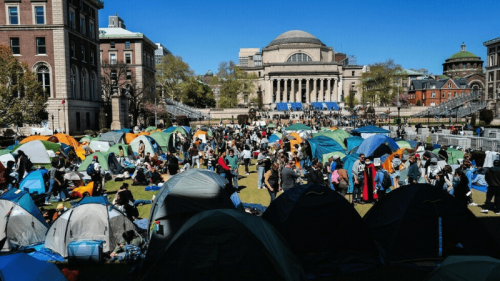IN the year 636, Abu Ubaidah besieged the city of Jerusalem, as part of the military conflict that lasted from 636-637 between the Byzantine army and the Rashidun Caliphate during Hazrat Umar’s reign. The Patriarch Sophronius agreed to surrender after six months of the siege but only on the condition that he would surrender the city to the caliph. Hazrat Umar then made the journey to Jerusalem, on a lone camel wearing simple woollen clothes accompanied by only one person who shared the camel with him.
When he arrived in Jerusalem, the Arab nobles who had conquered the city came to receive him. They were dressed in rich, Byzantine styled clothes, with fine robes, and when Hazrat Umar saw them he was incensed at the display of lavishness and worldliness.
The Patriarch Sophronius gave Hazrat Umar a tour of the holy city, including the Church of the Holy Sepulchre which is located in the Christian Quarter of the Old City of Jerusalem. It is considered to be one of the holiest sites in Christianity. The church contains, according to Christian tradition, the site where Jesus was crucified and his empty tomb where he was buried and then resurrected.
It is reported by Ibn Khaldun, the famous Arab historian and sociologist, that when it was time to pray the Patriarch Sophronius invited Hazrat Umar to pray in the courtyard of the church. Hazrat Umar refused and instead prayed outside the church. He later disclosed that he did so because he feared that his followers would turn the church into a mosque if he prayed there. There is a mosque built where Hazrat Umar prayed outside, by the name of Mosque of Umar. This mosque was built to commemorate this incident, and it acts as a physical symbol of the justice and principles that Hazrat Umar stood for.
Would Hazrat Umar have turned Hagia Sophia into a mosque?
The Church of the Hagia Sophia was built in 537 as the patriarchal cathedral of the imperial capital of Constantinople. It was the biggest church at that time and was considered the epitome of Byzantine architecture. Not only that, it contained a number of structural innovations, including one of the world’s first pendentive domes. Hagia Sophia’s unique architecture had a strong influence on future Ottoman architecture and on the work of the great Turkish architect Mimar Sinan.
Hagia Sophia also served as the centre of Orthodox Christianity from the time it was created to its conversion into a mosque in 1453 by Mehmed the Conqueror when he captured the Byzantine capital Constantinople. The bells, altar, baptistry and other Christian relics in the church were destroyed and thrown out. The intricate mosaics that adorned the church’s walls depicting various scenes of Jesus, Mother Mary, the angels and the saints were either destroyed or plastered over. In its place a mimbar, four minarets and the direction of the qibla were added to the church to signify its successful conversion into a mosque.
Read | Politics: The conversion of Hagia Sophia
In 1923, the Republic of Turkey was established by Mustafa Kemal Ataturk after he overthrew the last vestiges of the Ottoman Empire. In 1935, the secular state of Turkey reopened Hagia Sophia as a museum after it had been closed to the public for four years.
The museum of Hagia Sophia was one of Turkey’s most-visited tourist attractions, eliciting awe and wonder from people of all religions. Recently, however, as part of President Erdogan’s mainly political mission to Islamise Turkey, his cabinet operating under his decree reclassified it into a mosque, despite much criticism and condemnation from the Turkish opposition, Unesco and many other international leaders. Erdogan’s reconversion of Hagia Sophia into a mosque has been made on the basis that the Hagia Sophia was the sultan’s personal property and its status as a museum was unlawful under both Ottoman and Turkish law.
But if we were to look at the Hazrat Umar incident and the precedent that he wished to set for his followers, was the initial conversion of the Church of Hagia Sophia into a mosque by Mehmed the Conqueror ethical and in keeping with Islamic tradition? Would Hazrat Umar have turned Hagia Sophia into a mosque with the force that Mehmed used, and if it had been converted into a mosque would he have allowed it to remain as such, or would he have returned it to its original owners?
Would austere and simple Hazrat Umar have considered Hagia Sophia to be the sultan’s personal property, and would he have forcefully removed the Christian traces from the church for it to serve as a mosque? After all, the Church of the Holy Sepluchre remains a church to this day with its foundations and walls intact, its cross, altar and baptistry undamaged by anything other than time.
Zara Imran is a student of Development and Policy at Habib University. Arif Hasan is an architect.
Published in Dawn, August 23rd, 2020













































